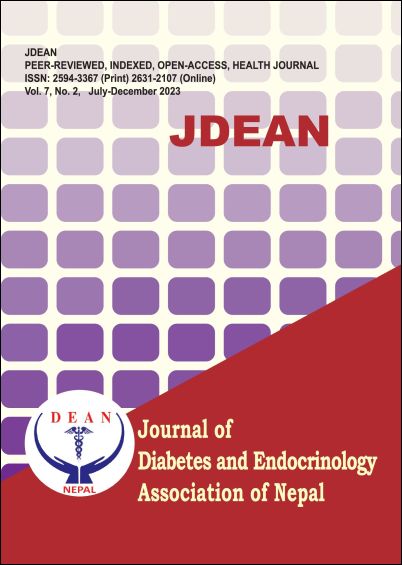Correlation of Neutrophil Lymphocyte ratio with HbA1c in patients of type 2 Diabetes Mellitus attending Medical Department of a Tertiary Care Centre
DOI:
https://doi.org/10.3126/jdean.v7i2.63895Keywords:
HbA1c, Glycemic control, Neutrophil lymphocyte ratioAbstract
Background: Type 2 diabetes mellitus is associated with chronic low-grade inflammation. Neutrophil lymphocyte is an indicator of subclinical inflammation. One of the novel inflammatory markers is neutrophil to lymphocyte ratio. We find only less studies that are directly accessing the relation between NLR and HbA1c, in the present study we aim to correlate neutrophil lymphocyte ratio with glycemic control in patients having type 2 diabetes.
Methods: Hospital based observational cross section study was carried out at department of medicine at Bharatpur Period August 2023 to December 2023. 176 patients with type 2 diabetes mellitus as per ADA criteria aged more than 18 years were included in the study. Microsoft excel and SPSS version 20.0 were used for collection and analysis of the data, p<0.05 was considered as significant.
Results: Out of 176 cases having mean age 55.78±9.111, Mean BMI of all participant was 28.37±4.061, mean absolute Neutrophil count was 7.36±7.123 10³/μl and Mean neutrophil lymphocyte ratio count was 4.03±1.545, in which 147 patients (83.5%) had NLR within normal limit, and remaining 29 patients (16.5%) had NLR within more than 3.53. In our study 123 patients (69.9%) had HbA1C more than 9.0. The association of NLR with HbA1c which was significant association (p=0.047) noted between two parameters indicating higher frequency of NLR had a positive correlation with HbA1c and was found to be an independent predictor of poor glycemic control in patients with type 2 diabetes mellitus.
Conclusions: Our study concluded that the association of NLR with HbA1c which was significant association. The Association of HbA1c with absolute neutrophil count was which significant and association of HbA1c with absolute lymphocyte count was which significant. Type 2 DM patients with raised NLR should be evaluated for cardiovascular, renal and ocular complications of diabetes. NLR may be useful as an easily measurable, noninvasive, widely available and cost-effective parameter for the disease monitoring tool during follow up of diabetic patients.
Downloads
Downloads
Published
How to Cite
Issue
Section
License
Copyright (c) 2023 The Author(s)

This work is licensed under a Creative Commons Attribution-NonCommercial 4.0 International License.
This license enables reusers to distribute, remix, adapt, and build upon the material in any medium or format for non-commercial purposes only, and only so long as attribution is given to the creator.




